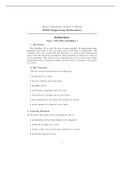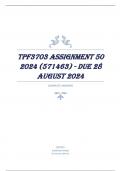School of Engineering, University of Warwick
ES193 Engineering Mathematics
Briefing Sheet:
Topic: VECTOR ALGEBRA I
1. Motivation
Real numbers tell us only the size of some quantity. In engineering many
properties have both a size and some form of direction or orientation. For
example a force has a magnitude and direction, or a point in three-dimensional
space is described by three coordinates. Such quantities are known as vectors or
vector quantities. This week we start exploring how vectors can be used. Many
applications such a computer graphics and the study of dynamics rely heavily
on vectors.
2. Key Concepts
The key concepts discussed in the readings are:
• definition of a vector
• vector addition and subtraction
• scaling vectors
• Cartesian component form of vectors
• equation of a straight line in vector form
• the definition of the scalar (dot) product of vectors
• the equation of a plane in vector form
3. Learning Outcomes
At the end of this week’s work you should be able to:
• manipulate vectors from simple vector diagrams
• find the modulus of a vector
• form a unit vector in the same direction as a vector
• add and subtract vectors
1
, • carry out relative velocity calculations
• express the equation of a straight line in standard form
• from the standard form of the equation of a straight line find a point on
the line and a vector parallel to the line (and vice-versa)
• calculate the scalar product of two vectors
• find the angle between two vectors
• calculate the work done when a force moves its point of application
• find the projection of one vector in the direction of another vector
• calculate the equation of a plane from the normal vector and a point in
the plane (and vice-versa)
• find the angle between two planes
• find the perpendicular distance of a point to a plane
2
, 4. This Week’s Reading
For this week’s work we move to Chapter 14 of the book. We will do the whole
of the chapter; one aspect of vectors will be left until next week’s work.
As in previous weeks, I am suggesting certain questions from the block exercises
which serve to help you learn. You should do as many of these as you feel
necessary to be confident that you have understood the topic. Again, it is the
revision questions in §6 which will determine whether your understanding and
skills are sufficient to be able to cope with examination-type questions.
5. Example Problems
Chapter 14
Pages 671-684: BLOCK 1: Basic concepts of vectors
(Read the first part, pp. 671-673, quickly; vector addition, scaling and subtrac-
tion are more important; Also, resolving vectors is important, eg. for Statics)
Exercises: Page 673, Q1; Page 676, Q1, Q2 Q3 (all easy!); Page 681,
Q1, Q2, Q4; Page 683, Q1, Q2, Q3; Page 684 (End-of-block), Q4
Pages 685-702: BLOCK 2: Cartesian components of vectors
Note: this does NOT include §2.6.
(The unit vectors, i and j, in the x and y directions; vectors in i-, j-component
form; direction cosines (for interest only); three-dimensional (3D) coordinate
frames; direction ratios and 3D direction cosines for interest only.)
Exercises: Page 692, Q3, Q4, Q6; Page 697, Q1, Q2 (a), (b) & (c)
only, Q3, Q4; Page 701-702 (End-of-block), Q1, Q3, Q4
Pages 703-714: BLOCK 3: The scalar, or dot, product
Note: Ignore example 3.15
(Definition, properties, dot-product formula for vectors in component form (note
that the formula is in the Data Book (Seventh Edition), Page 10); angle between
vectors; projection of a vector onto a different direction.)
Exercises: Page 705, Q2, Q3, Q4, Q5; Page 707, Q1; Page 709,
Q1, Q3, Q4 (important!); Page 710, Q1; Page 713-714, Q1, Q3; Page 714
(End-of-block), Q4, Q5, Q10
MISS OUT BLOCK 4.... for the moment - we will return to it later
Pages 726-739: BLOCK 5: Vector equation of a line and plane
3





